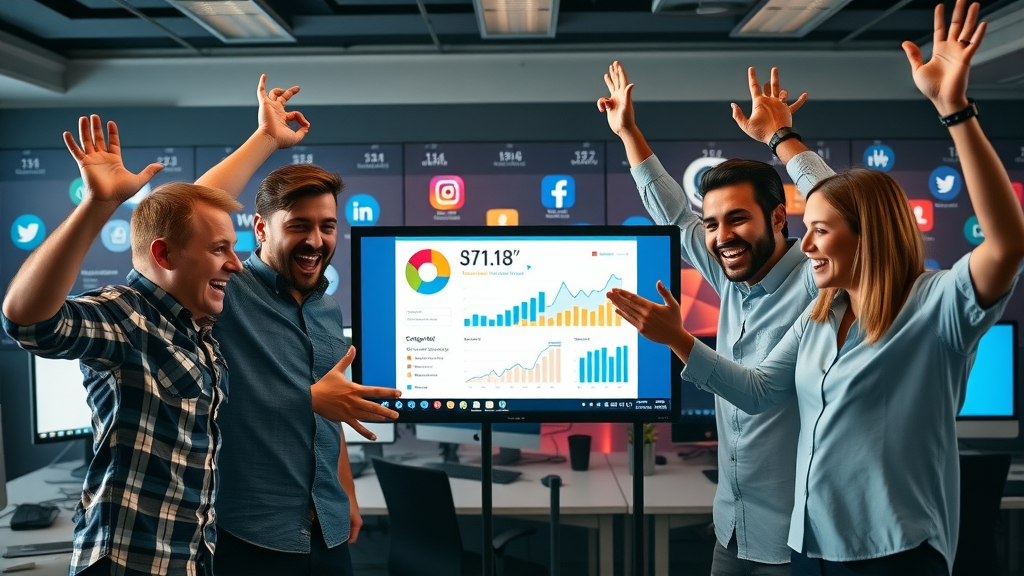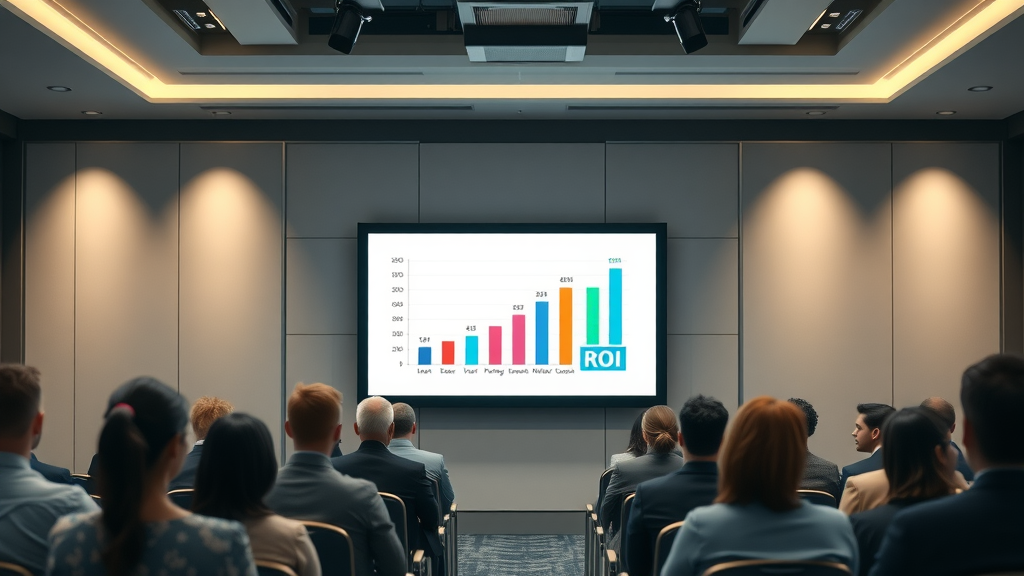Did you know: In 2024, 60% of digital marketers report declining ROI on their paid social campaigns? If you’re seeing underwhelming results—or haven’t audited your media ad strategy in months—this could be your last chance before competitors accelerate ahead. The difference between thriving visibility and wasted budget comes down to what you do right now. Read on to discover timely actions, proven tactics, and the latest trends to revive your paid social campaigns and ensure your media ad dollars work harder for your brand.
What You’ll Learn About Optimizing Paid Social Campaigns
- How to audit your current paid social media campaigns for instant improvement opportunities.
- Proven strategies that revive paid social media ad performance and boost ROI.
- The latest tactics for leveraging new social media platform features and innovative ad formats.
- How to measure, track, and optimize your paid social campaigns ongoing for maximum impact.
Startling Trends: The Critical Moment for Paid Social Campaigns
"Did you know that 60% of digital marketers report declining ROI on their paid social campaigns in 2024? The time to act is now—or risk being left behind in the world of paid social media advertising."

The paid social campaigns landscape has shifted dramatically over the past year. Despite mounting budgets for media ads and ambitious ad campaign goals, rising costs and sophisticated algorithm changes across social media platforms mean it's harder than ever to achieve prior results. Brands relying on outdated strategies or neglecting regular campaign audits are seeing performance drop off a cliff—a trend underscored by digital marketers everywhere. This critical moment is not just about loss of reach or engagement, but about the financial health of your entire digital marketing ecosystem. If you’re reading this, it’s likely your paid social campaigns are at risk. With media ad performance in flux and emerging platforms shaking up the rules, waiting even a few weeks can cost you months of momentum, valuable audience attention, and much-needed conversion growth.
To remain competitive, you must adopt proactive tactics, investigate new social ad formats, and keep your finger on the pulse of social media platform shifts. Paid social media campaigns are no longer set-it-and-forget-it. Data-driven agility, real-time measurement, and continuous creative innovation are now table stakes. The urgency is real: brands and agencies that pivot now stand to not only protect ROI but emerge as leaders in the new media campaign landscape.
Why Paid Social Campaigns Are at a Tipping Point
- Platform saturation: Audiences are bombarded with a flood of media ads and social ads, increasing competition for limited attention.
- Rising media ad costs: As more brands invest, media advertising spend continues to climb, driving up the cost per acquisition (CPA) and challenging ROI expectations.
- Evolving audience targeting algorithms: Continuous adjustments in social media and paid social ad platform algorithms require marketers to update their targeting, creative, and measurement strategies constantly to prevent performance erosion.
With social media platform changes, the very foundation of paid social campaigns is being rewritten. Even high-spending brands are discovering that old-school “boosted post” strategies or running the same creative across all channels aren’t enough. The key drivers above make rapid adaptation and mastery of new tools, techniques, and audience insights not just an advantage but a necessity for paid social campaign survival.
Anatomy of Successful Paid Social Campaigns: Social Media Ad Foundations
What Makes a Paid Social Campaign Succeed in 2024?

The anatomy of successful paid social campaigns in 2024 comes down to three core elements—data-driven targeting, dynamic creative, and agile optimization. Winning a crowded “media ad” landscape means treating every paid ad as an experiment. Top-performing social media campaigns leverage advanced analytics to zero in on target audience segments with precision, frequently test fresh ad formats (especially video ad and story-based formats), and rotate creative content to combat ad fatigue. It’s not about how much you spend, but how quickly you adapt insights to action.
Successful media advertising now demands a cross-platform approach. Savvy marketers blend paid social media ads with engaging organic social content for authenticity, while leveraging each platform's unique data and features. Automated rules, real-time creative swaps, and granular performance monitoring ensure nothing slips through the cracks. The brands winning today are those that combine emotional storytelling with relentless data analysis, viewing every click and conversion as feedback to inform the next iteration of their paid social campaign.
Paid Social vs Paid Social Media: What’s the Difference?
| Type | Reach | Engagement | ROI |
|---|---|---|---|
| Paid Social Campaigns | Highly targeted, campaign-focused audiences across platforms | Customizable (high with advanced creative) | Strong (when regularly optimized and measured) |
| Paid Social Media Ads | Vast, scalable audience via platform-specific placements | Moderate to high (varies by ad format) | Variable (requires continuous creative refreshes) |
| Organic Social Media Strategies | Follows/fans only; dependent on algorithm | High authenticity, lower reach | Low—unless paired strategically with paid |
Paid social refers to structured media campaigns—strategic, objective-driven units leveraging cross-channel placements and robust performance tracking. Paid social media ads include any media ad placed via a social platform's paid infrastructure. Meanwhile, organic social is all about unpaid posts to your own followers; it can compound the effectiveness of your paid social efforts when used together in a unified marketing funnel.
Media Platform Selection: Choosing Where Your Paid Social Ad Will Win
Not all social media platforms are created equal—especially for paid social campaigns. Facebook ad placements may deliver cost-effective reach for certain audiences, while Instagram excels with visually driven demographics. TikTok’s explosive format favors brands with high video ad production value and creative muscle, and LinkedIn dominates for B2B or professional ad campaigns.
Identifying the right media platform involves analyzing first-party and platform data, exploring engagement rates, and understanding which channel best matches your target audience and campaign goals. Don't discount niche platforms like Pinterest or X (Twitter) if your audience segments are highly active there; often, platform diversification can yield new, lower-cost leads. The most effective paid social media campaigns blend placements across several platforms, but remain agile—always shifting spend toward channels that outperform in real time.
Step 1: Comprehensive Paid Social Audit—Identify Weaknesses in Your Paid Social Campaigns
- Review your social media campaign objectives and clarify core KPIs.
- Analyze historical spend, CPA, and performance across each media ad within your campaign.
- Identify gaps in audience targeting, creative messaging, and use of new ad formats.
Start a paid social campaign turnaround with a rigorous audit. Scrutinize spend distribution, performance metrics like cost per click or action, and the ROI of every media campaign running across your social media platforms. Are you tracking the right KPIs, or defaulting to vanity metrics? Examine every creative asset and ad format—are you still using outdated video ad specs, or stuck with static images where motion would attract more engagement?
Uncovering weaknesses requires a granular breakdown of results, audience overlaps, and creative fatigue. A comprehensive paid social audit enables you to quickly spot lost opportunities, poorly allocated budget, and mismatches between message and audience. Use this opportunity to reevaluate goals, reallocate spend to better-performing media platforms, retire underperforming ad formats, and lay a strong foundation for a revitalized paid social campaign.
Step 2: Rebuilding Your Paid Social Campaign Strategy for ROI
- Define new KPIs for paid social—Shift from soft metrics (likes, shares) to actionable ROI drivers (leads, purchases).
- Adapt to social media advertising algorithm changes—Stay informed on platform updates that affect ad delivery and paid ad reach.
- Integrate advanced audience targeting and paid ad placements—Use lookalike modeling, interest targeting, and automated placements for precision.
- Harness video ad innovation and trending ad format options—Prioritize immersive media ads like vertical video, interactive stories, and dynamic carousels.
Transform your paid social strategy by realigning goals and incorporating the latest media advertising tactics. Replace legacy KPIs with metrics that show true progress—such as cost per lead, customer lifetime value, or return on media ad spend. Watch for algorithm alerts from platforms like Facebook or TikTok; even minor changes can impact who sees your social ads, requiring new creative and targeting experiments.
Employ layered audience targeting and dynamic ad placement tools to sidestep rising costs and find hidden pockets of value. Media ads powered by video, stories, and interactive features are outperforming static formats in both engagement and conversion. Don’t be afraid to test bold new video ad types or explore less familiar media platforms if the data supports a shift—data-driven agility is the new campaign superpower.
Expert Insights: Quotes from Social Media Advertising Leaders
"The difference between a stalled campaign and a thriving paid social campaign is data-driven agility and creative testing." – Jane Thompson, Digital Strategy Director
"Paid social media ad fatigue is real. Marketers must continuously innovate with ad format and messaging." – Rahul Patel, Paid Social Analyst
Social Media Platform Shifts: Where Paid Social Campaigns Performed Best in 2024
| Platform | Audience Reach | Cost | Engagement |
|---|---|---|---|
| Massive; all demographics | Moderate | High, especially with targeted video ad | |
| Millennial/Gen Z, visually engaged | Higher | Very high with stories and reels ad formats | |
| TikTok | Gen Z, trend-focused | Low to moderate | Extremely high (short-form video ad brightest) |
| B2B professionals | High | Moderate, excellent for lead generation | |
| X (Twitter) | News, culture, tech-savvy groups | Low | Lower, but effective for live events |
| DIY, lifestyle, inspiration seekers | Low | High for visual commerce |
The best paid social media campaigns in 2024 adapted to these shifts, customizing media ad strategies by platform, testing new video ad innovations, and pinning their creative to audience preferences unique to each network. Continuously reassessing which social media platform yields maximum ROI is mandatory in today’s dynamic digital landscape.
Step 3: How to Improve Paid Social Ad Creative for Maximum Impact
- Deploy a mix of multimedia formats and rich video ad content to cut through the social media noise.
- Test multiple ad format combinations (carousel, stories, interactive posts) to discover which resonates best with your target audience.
- Employ rigorous A/B split testing to compare media ad creative, copy, and CTA for higher social ad engagement and lower costs.

Maximize the impact of your paid social campaigns by elevating creative. In 2024, static image ads alone rarely deliver stellar social ad performance. Instead, integrate bold video ads, animated graphics, and interactive features that make users want to engage, share, or click.
Make every creative decision data-driven: test new ad formats, experiment with copy length, or even change colors and calls to action. Successful media ad creative is never set in stone—it’s a moving target informed by real-time audience response. Use A/B split testing religiously, track engagement metrics, and quickly scale up creatives that outperform benchmarks. Remember, the little tweaks—like swapping video ad covers or updating carousel images—often spark the biggest lift in paid social media ad results.
Emerging Ad Formats: Video Ad Dominance in Social Media Advertising
Video ad formats have taken center stage in paid social campaigns. Whether it’s a 15-second TikTok, a looping Instagram Reel, or a dynamic Facebook video ad, all the latest data points to higher engagement, better recall, and greater ROI with video. The social media ad landscape now prioritizes movement, story, and interactivity.
To leverage this dominance, invest in both production quality and storytelling. Experiment with short- and long-form videos, captions, and platform-native features (like AR filters or shopping tags). Keep testing to discover what resonates—and remember: social media users scroll fast, so your message must capture attention immediately. Creatives that entertain, inform, or surprise are more likely to drive shares, discussion, and downstream conversions.
Step 4: Advanced Audience Targeting for Paid Social Campaigns
- Lookalike audience modeling—Leverage existing customer data to reach new, highly relevant users on each media platform.
- Interest-based targeting—Segment ads on social media by specific behaviors, preferences, or in-market signals.
- Dynamic retargeting—Serve personalized social ads to users based on past actions, optimizing for conversions in your paid social media campaigns.
Advanced audience targeting is now the cornerstone of effective paid social campaigns. It’s not enough to broadly target “18–35 year olds”—modern media ads go after microsegments, using AI, machine learning, and real-time data to refine who sees your ad and when. Lookalike audience modeling (available on most major social media platforms) makes your best customers a template for finding new high-value users. Meanwhile, robust interest-based targeting ensures each ad is relevant to users’ actual browsing and purchase behavior.
Don’t forget dynamic retargeting. Serving tailored creative and personalized offers to users who didn’t convert the first time around can dramatically lift your campaign's bottom line. With all these tools, continuous monitoring and optimization are still essential; rapid shifts in user interests and platform rules mean paid social media campaign targeting should never be static.
Step 5: Measuring, Tracking, and Reporting Paid Social Campaign Success
- Set up UTM tracking on every media ad to properly attribute traffic and conversions.
- Build real-time dashboards that aggregate performance metrics across social media platforms for fast insights.
- Apply attribution modeling to understand true cross-platform paid social campaign lift—from first click to final sale.

Tracking is the linchpin of modern paid social campaigns. Without accurate measurement, even the sharpest media marketing strategy is flying blind. Use UTM codes to ensure every click, view, and action from your social media ads can be traced directly to their source. Go beyond native platform analytics by setting up custom dashboards that consolidate all media campaign data into actionable insights.
Attribution modeling further elevates your reporting: instead of crediting last-click interactions, accurate models show how multiple paid ads and touchpoints contribute to the ultimate goal—be it a sale, signup, or download. This holistic view ensures budget is always funneled toward the highest-performing channels, creatives, and audience segments.
Lists: Top 10 Common Mistakes in Paid Social Campaigns and How to Fix Them
- Neglecting clear campaign objectives—Re-define and align all your social ads to precise goals.
- Ignoring social media platform updates—Stay current or risk declining paid ad reach and ROI.
- Poor budget allocation—Routinely shift spend to top-performing ads and media platforms.
- Weak creative messaging—Test diverse creatives, visuals, and copy for improved engagement.
- Missing advanced audience targeting—Implement lookalike and interest-based targeting immediately.
- Underestimating ad format diversity—Try video ad, carousel, stories, and more.
- Measuring the wrong KPIs—Focus on sales or conversions over vanity metrics.
- Inadequate A/B testing—Test every major aspect of your paid social media ad creative.
- Not optimizing video ad content—Edit for attention, clarity, and mobile-friendliness.
- Failing to retarget and remarket—Launch retargeting campaigns for higher conversion rates.
Real Case Studies: Paid Social Campaigns That Turned Around
- A lifestyle brand improved social media ads ROI by 300% by switching to vertical video ad and refining their target audience with lookalike modeling.
- A B2B company doubled conversions in their paid social media campaign after implementing advanced targeting and dynamic creative testing on LinkedIn and Facebook.
- An e-commerce brand rapidly recovered from declining sales by pivoting creative formats when new platform algorithm changes hit—testing new ad formats weekly and scaling only the best performers.

These real-world examples demonstrate the impact of agility and data-driven action in turning around struggling paid social campaigns. Whether it’s vertical video for social ads or advanced AI-driven targeting on emerging media platforms, measurable success comes to those who test, adapt, and scale what works—fast.
How Emerging Technologies & AI Impact Paid Social Campaigns
- AI-driven audience targeting and social ad personalization allow for hyper-specific, cost-efficient media advertising at scale.
- Automated ad format selection rapidly identifies the creative types your target audience prefers.
- Machine learning tools analyze campaign data in real time, optimizing media ad spend and creative rotation without human intervention.
The newest wave of paid social campaign performance is being powered by artificial intelligence and machine learning. AI algorithms identify high-probability conversion segments, recommend new ad formats, and automatically adjust bids and placements for optimal efficiency. For brands, this means less guesswork and more scalable, sustainable results across every social media platform.
As major media advertising channels continue to roll out advanced automation, marketers who embrace these tools will pull ahead—improving ROI and freeing up time for creative storytelling and strategy. If you haven’t started experimenting with AI-driven ad optimization, now is the time to test and learn.
People Also Ask: What is the highest paid social platform?
Answer: Currently, Facebook and Instagram offer the highest earning potential for paid social campaigns, driven by extensive user targeting and advanced social media advertising tools. However, TikTok and LinkedIn are rapidly growing platforms for media ad performance in specific verticals.
People Also Ask: What is the 50/30/20 rule for social media?
Answer: The 50/30/20 rule in social media content planning recommends allocating 50% of content to engagement and value, 30% to media advertising or promotional content, and 20% to shared industry content. This balance supports successful paid social campaigns by maximizing engagement while driving conversions.
People Also Ask: Are paid social media ads worth it?
Answer: Yes, paid social media ads within well-optimized paid social campaigns can significantly boost brand awareness, lead generation, and sales. Success depends on proper media platform selection, ongoing creative testing, and robust audience targeting.
People Also Ask: Is there a paid social media?
Answer: Paid social media refers to paid placements of your brand's content on social media platforms through media ads—distinct from organic posting and typically in the form of display, video ad, or sponsored content.
FAQs on Paid Social Campaigns, Media Advertising, and Social Ad Optimization
-
What budget should I allocate for a new paid social campaign?
Start with a flexible budget—often 10–20% of total digital media spend. Adjust weekly based on performance data from media ads and optimize for the platforms or ad formats yielding the best results. -
How can I tell if my social media ad is underperforming?
Watch for high CPM/CPC, low engagement, declining reach, or stagnant conversions. If creative and targeting changes do not move KPIs, consider a full campaign reset or platform reallocation. -
Should I use the same creative across all paid social media platforms?
No—each media platform has unique audience behaviors and preferred ad formats. Customize creatives by platform, adapting visuals, messaging, and video ad specs for higher relevance and conversion. -
What are the best metrics for media ad success?
Focus on direct response KPIs: cost per acquisition (CPA), click-through rate (CTR), return on ad spend (ROAS), and conversion rate, rather than just impressions or likes. -
How often should I refresh my paid social ad creatives?
At least every 4–6 weeks, or sooner if you detect ad fatigue or declining engagement. A/B test new creative and rotate formats to keep your audience engaged.
Key Takeaways for Refreshing Paid Social Campaigns Now
- Audit your paid social campaigns immediately—Don’t wait for further declines.
- Stay highly adaptive to constant changes in social media advertising platforms.
- Harness innovative ad formats and creative strategies for standout results.
- Maintain a sharp focus on data-driven audience targeting and optimize media ads persistently.

Watch our concise video tutorial to discover the five most effective strategies for breathing new life into struggling paid social campaigns—from creative A/B testing to leveraging machine learning tools.
Spot trouble early! This quick video highlights red flag performance metrics, creative pitfalls, and ways to course-correct before wasted ad spend becomes permanent loss.
Stay ahead of the curve with an expert breakdown of emerging trends, must-try ad formats, and key audience shifts shaping the future of paid social campaigns.
Conclusion: Time is Running Out for Paid Social Campaigns—Act Today
- Act with urgency—This window of opportunity for paid social campaigns is rapidly closing with ongoing media platform changes.
- Revisit and reboot your paid social campaigns—Use insights and strategies from this guide to spark immediate improvements.
- Start now—The brands that adapt win. The time to save your media ad ROI is now.
 Add Row
Add Row  Add
Add 




Write A Comment